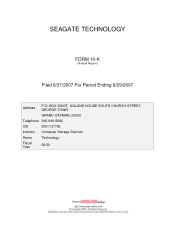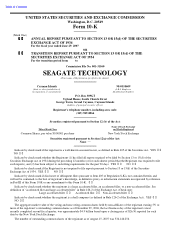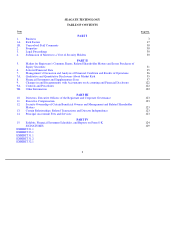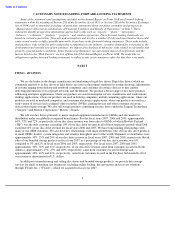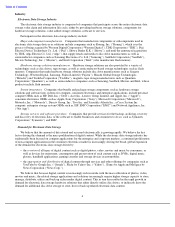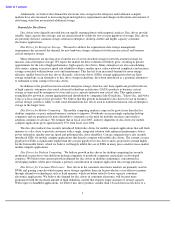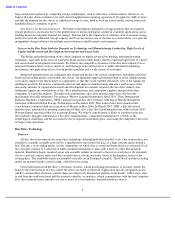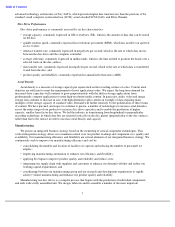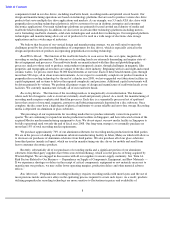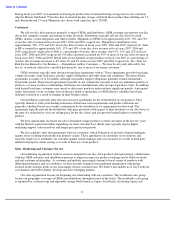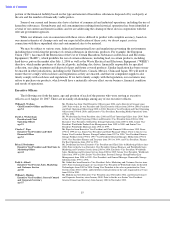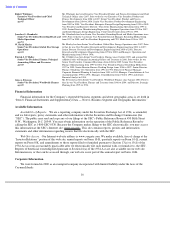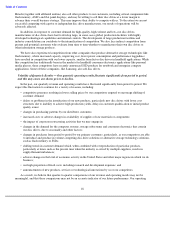Seagate 2006 Annual Report Download - page 11
Download and view the complete annual report
Please find page 11 of the 2006 Seagate annual report below. You can navigate through the pages in the report by either clicking on the pages listed below, or by using the keyword search tool below to find specific information within the annual report.
Table of Contents
components found in our disc drives, including read/write heads, recording media and printed circuit boards. Our
design and manufacturing operations are based on technology platforms that are used to produce various disc drive
products that serve multiple disc drive applications and markets. As an example, our 3.5-inch ATA disc drive with
perpendicular recording technology platform is sold to customers for use in desktop, enterprise and consumer
electronics applications. Our main technology platforms are primarily focused around areal density of media and
read/write head technologies. In addition, we also invest in certain other technology platforms including motors,
servo formatting read/write channels, solid-state technologies and sealed drive technologies. Our integrated platform
technologies and manufacturing allow our set of products to be used in a wide range of electronic data storage
applications and in a wide range of industries.
We believe that because of our vertical design and manufacturing strategy, we are well suited to meet the
challenges posed by the close interdependence of components for disc drives, which is especially critical in the
design and production of products incorporating perpendicular recording technology.
Read/Write Heads. The function of the read/write head is to scan across the disc as it spins, magnetically
recording or reading information. The tolerances of recording heads are extremely demanding and require state-of-
the-art equipment and processes. Our read/write heads are manufactured with thin-film and photolithographic
processes similar to those used to produce semiconductor integrated circuits, though challenges in magnetic film
properties and topographical structures are unique to the disc drive industry. Beginning with six and eight-
inch round
ceramic wafers, we process more than 30,000 head elements at one time. Each of these head elements goes through
more than 500 steps, all in clean room environments. As we expect to essentially complete our product transition to
perpendicular recording technology by the end of calendar year 2008, we have upgraded our fabrication facilities in
capital equipment and systems to deliver the required complexity and precision. Additional capital investments will
be driven primarily by volume. We perform all primary stages of design and manufacture of read/write heads at our
facilities. We currently manufacture virtually all of our read/write heads.
Recording Media. The function of the recording media is to magnetically store information. The domains
where each bit of magnetic code is stored are extremely small and precisely placed. As a result, the manufacturing of
recording media requires sophisticated thin-film processes. Each disc is a sequentially processed set of sputtered
layers that consist of structural, magnetic, protective and lubricating materials deposited on a disc substrate. Once
complete, the disc must have a high degree of physical uniformity to assure reliable and error-
free storage. Recording
media is deposited on aluminum or glass substrates.
The percentage of our requirements for recording media that we produce internally varies from quarter to
quarter. We are continuing to expand our media production facilities in Singapore, and have relocated certain of the
acquired Maxtor media manufacturing equipment to Asia. We do not expect our new media facility in Singapore to
be fully operational until towards the end of fiscal year 2008. Our long-term strategy is to externally purchase no
more than 15% of total recording media requirements.
We purchase approximately 70% of our aluminum substrates for recording media production from third parties.
We are in the process of adding an aluminum substrate manufacturing facility in Johor, Malaysia which will allow us
to decrease our purchases of aluminum substrates from third parties. We also purchase all of our glass substrates
from third parties (mainly in Japan), which are used in manufacturing our disc drives for mobile and small form
factor consumer electronics products.
Recently, substantially all of our purchases of recording media and a significant portion of our aluminum
substrates from third-party suppliers have been sourced from Komag, which is in the process of being acquired by
Western Digital. We are engaged in discussions with all our suppliers to ensure supply continuity. See “Item 1A.
Risk Factors Related to Our Business — Dependence on Supply of Components, Equipment, and Raw Materials —
If we experience shortages or delays in the receipt of critical components, equipment or raw materials necessary to
manufacture our products, we may suffer lower operating margins, production delays and other material adverse
effects.”
Raw Materials. Perpendicular recording technology requires recording media with more layers and the use of
more precious metals and scarce alloys in the sputtering process required to create such layers. As a result, products
utilizing perpendicular recording technology are more sensitive to fluctuations in prices and availability of
8

